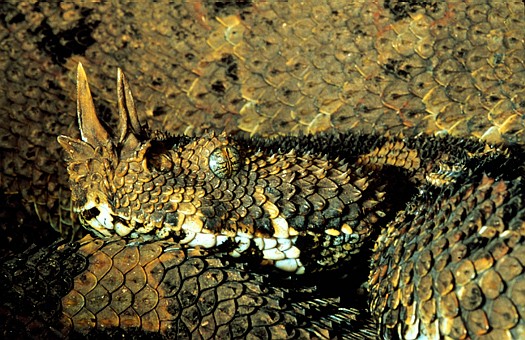Scientific Name: Bitis nasicornis
Family: Viperidae
Adult Size: 2½ to 3 feet long, with a very stout body
Range: Found widely across central tropical Africa from Guinea and Liberia on the western coast through the Congo to Kenya.
Habitat: Rhinoceros vipers are a species of deep rain forests and often are associated with forest pools and low areas that flood regularly. It is a very sedentary ambush predator but a climbs surprisingly well.





Most specimens are wild-caught and should be thoroughly vetted for intestinal and other parasites, neck problems and paramyxovirus infection (“star-gazing disease”). They also may be severely dehydrated and need to be soaked as they adapt to the terrarium. The terrarium should be at least equal to the length of the snake, so plan for roughly 4 feet square for an adult. It should be about 3 feet high, with a basking light placed toward the top of the terrarium. For a substrate use 2 inches of sphagnum moss, orchid bark or any other material that can hold a high moisture content. The terrarium should be waterproofed. Provide a large, shallow water bowl in which the snake can soak; change the water regularly. The temperature should be kept low, just 70 to 78 degrees Fahrenheit. Persistent temperatures over 80 degrees can lead to dehydration and death. A lockable hide box is essential.
Rhinoceros vipers spend much of the day partially hidden in the substrate and are most active at night. They take a variety of prey, ranging from hopper mice for young specimens to rats for large adults. Difficult feeders may take gerbils when other rodents are refused. In the wild, frogs and fish also are eaten.
The venom of the rhinoceros viper is considered to be relatively weak and is more likely to cause severe tissue damage than death, but certainly a bite is not pleasant. Antivenin for gaboon vipers works for this species as well.










Family: Viperidae
Adult Size: 2½ to 3 feet long, with a very stout body
Range: Found widely across central tropical Africa from Guinea and Liberia on the western coast through the Congo to Kenya.
Habitat: Rhinoceros vipers are a species of deep rain forests and often are associated with forest pools and low areas that flood regularly. It is a very sedentary ambush predator but a climbs surprisingly well.





Most specimens are wild-caught and should be thoroughly vetted for intestinal and other parasites, neck problems and paramyxovirus infection (“star-gazing disease”). They also may be severely dehydrated and need to be soaked as they adapt to the terrarium. The terrarium should be at least equal to the length of the snake, so plan for roughly 4 feet square for an adult. It should be about 3 feet high, with a basking light placed toward the top of the terrarium. For a substrate use 2 inches of sphagnum moss, orchid bark or any other material that can hold a high moisture content. The terrarium should be waterproofed. Provide a large, shallow water bowl in which the snake can soak; change the water regularly. The temperature should be kept low, just 70 to 78 degrees Fahrenheit. Persistent temperatures over 80 degrees can lead to dehydration and death. A lockable hide box is essential.
Rhinoceros vipers spend much of the day partially hidden in the substrate and are most active at night. They take a variety of prey, ranging from hopper mice for young specimens to rats for large adults. Difficult feeders may take gerbils when other rodents are refused. In the wild, frogs and fish also are eaten.
The venom of the rhinoceros viper is considered to be relatively weak and is more likely to cause severe tissue damage than death, but certainly a bite is not pleasant. Antivenin for gaboon vipers works for this species as well.










No comments:
Post a Comment